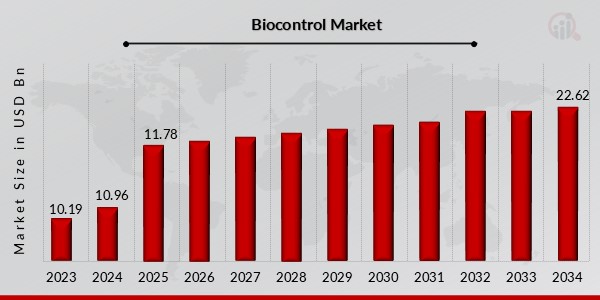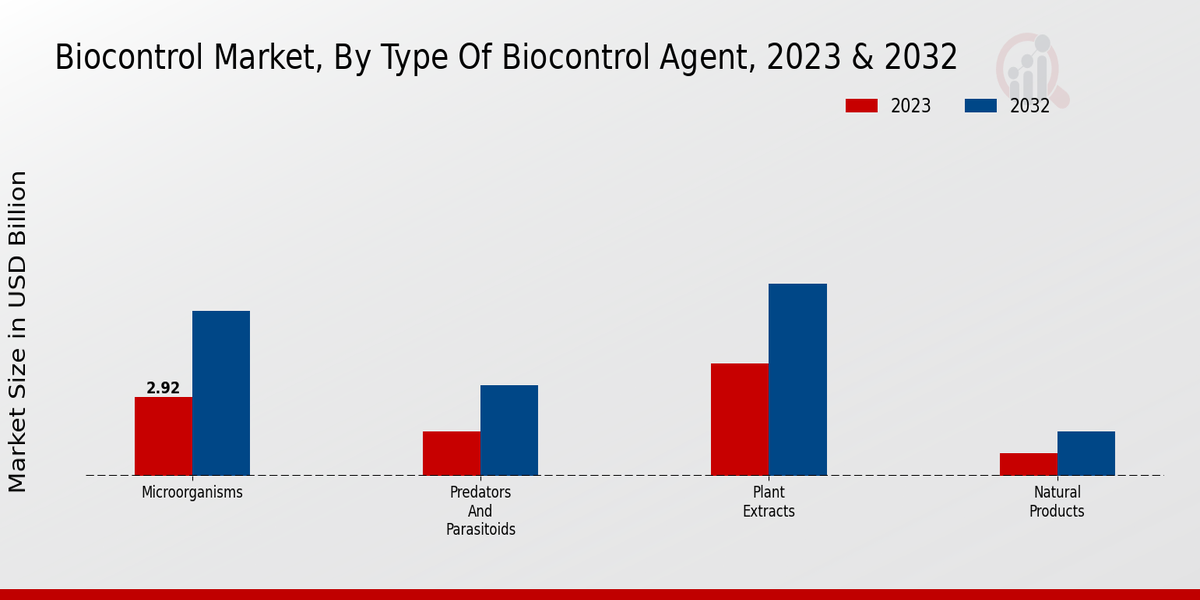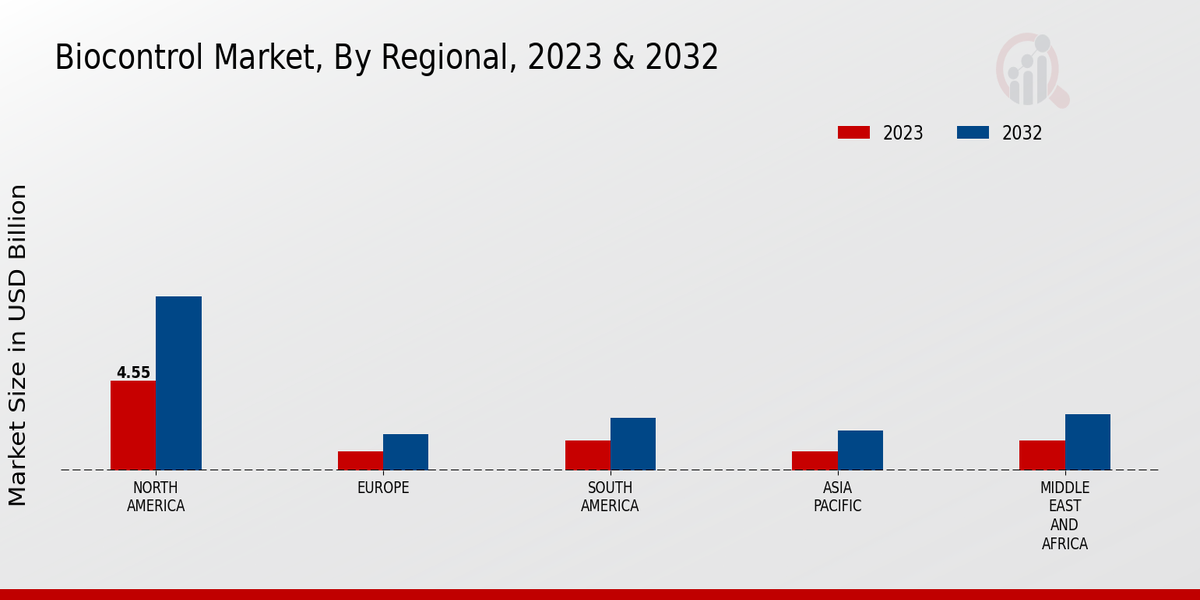Global Biocontrol Market Overview
Biocontrol Market Size was estimated at 10.96 (USD Billion) in 2024. The Biocontrol Market Industry is expected to grow from 11.78 (USD Billion) in 2025 to 22.62 (USD Billion) by 2034. The Biocontrol Market CAGR (growth rate) is expected to be around 7.5% during the forecast period (2025 - 2034).

Source: Primary Research, Secondary Research, MRFR Database and Analyst Review
Key Biocontrol Market Trends Highlighted
The biocontrol market is driven by increasing concerns about the adverse effects of chemical pesticides, rising demand for sustainable pest management practices, and supportive government regulations promoting eco-friendly farming methods. These factors have prompted farmers to shift towards biocontrol agents as a viable alternative for pest control.
Opportunities in the market include the development of innovative biocontrol products, such as targeted delivery systems, improved formulations, and enhanced performance against specific pests. Additionally, the expansion of organic farming and the use of biocontrol in urban landscapes present untapped growth potential.
Recent trends in the biocontrol market include the integration of biocontrol with precision agriculture, the adoption of biological control as a part of integrated pest management strategies, and the development of biopesticides that combine biocontrol agents with other active ingredients. These advancements aim to improve the efficacy, reliability, and overall sustainability of pest control measures.
Biocontrol Market Drivers
Rising Adoption of Sustainable Farming Practices
Awareness is increasing regarding health and environmental hazards by synthetic pesticides and fertilizers. More and more number of people are moving towards better sustainable farming practice. Biocontrol agents offer a natural way which is an eco-friendly substitute for the chemical methods. Growing requirement for food with biocontrol agents is expected to be a major market driver for the industry.
Government Regulations and Support
Nowadays, with the growing number of regulations on synthetic pesticides utilization developed by different governments throughout the world, the popularity and applicability of biocontrol agents has been rising remarkably for their use in the areas adjacent to water reservoirs and settlements. Because of the rising demand for eco-friendly and biologically acceptable pest-control agents, the market of biocontrol agents is promoted by the increasing demand and, therefore, the supply on the part of the governmental sector.
For instance, in certain cases, the government either directly invests in the development of the biocontrol market or supports the companies with subsidies to make them more affordable for the business sector.
Advancements in Biotechnology and Research
Biotechnological and research processes and methods development are resulting in better and more targeted biocontrol agents. Scientists are constantly on the hunt for new strains of microorganisms, insects, and the like, their natural enemies, and their potential and newly discovered abilities to control pests. As a result, more and more pests can be addressed by these agents, and their potential market expands.
Biocontrol Market Segment Insights
Biocontrol Market Type of Biocontrol Agent Insights
The Biocontrol Market is segmented into various types of biocontrol agents, including microorganisms (bacteria, fungi, viruses, protozoa), predators and parasitoids (insects, mites, nematodes), plant extracts (botanicals, essential oils, secondary metabolites), and natural products (biopesticides, biostimulants). In 2023, the microorganisms segment held the largest market share, accounting for approximately 45% of the market revenue. This dominance is attributed to the widespread adoption of microbial biocontrol agents in agriculture due to their effectiveness against a broad spectrum of pests and diseases, as well as their compatibility with integrated pest management (IPM) programs.
The market for microorganisms is projected to maintain its leading position throughout the forecast period, reaching a valuation of around USD 10.2 billion by 2032. The predators and parasitoids segment is another significant segment in the Biocontrol Market, holding a market share of around 25% in 2023. These agents are natural enemies of pests, and their use in biological control programs has gained traction due to their ability to target specific pests without harming beneficial insects. The growing awareness of the negative impacts of chemical pesticides on the environment and human health is driving the adoption of predators and parasitoids as sustainable pest management solutions.
This segment is anticipated to register a steady growth rate during the forecast period, reaching a market value of approximately USD 5.6 billion by 2032. Plant extracts and natural products represent emerging segments in the Biocontrol Market, offering promising alternatives to synthetic pesticides. Plant extracts are derived from various plant species and possess insecticidal, fungicidal, and herbicidal properties. Natural products, such as biopesticides and biostimulants, are derived from natural sources and are gaining popularity due to their low toxicity and compatibility with organic farming practices.
These segments are expected to witness significant growth in the coming years, driven by the increasing demand for sustainable and environmentally friendly pest management solutions. Overall, the Biocontrol Market presents a dynamic and promising landscape, with various types of biocontrol agents catering to specific pest management needs. The market is anticipated to grow steadily in the coming years, driven by the rising adoption of sustainable and eco-friendly pest management practices, increasing awareness of the harmful effects of synthetic pesticides, and growing demand for organic produce.

Source: Primary Research, Secondary Research, MRFR Database and Analyst Review
Biocontrol Market Application Insights
The Biocontrol Market segmentation by Application includes Agriculture, Horticulture, Forestry, Home and Garden, and Public Health. Agriculture is the largest application segment, accounting for over 50% of the market revenue in 2023. The growth of this segment is attributed to the increasing demand for sustainable and environmentally friendly crop protection solutions. Horticulture is another significant segment, driven by the growing adoption of biocontrol agents in greenhouse and nursery operations. Forestry, Home and Garden, and Public Health are also expected to witness steady growth in the coming years due to rising awareness about the benefits of biocontrol methods.
Biocontrol Market Target Pest/Pathogen Insights
The Target Pest/Pathogen segment plays a crucial role in shaping the Biocontrol Market segmentation. Insects (aphids, beetles, caterpillars, flies) held the largest market share in 2023, accounting for nearly half of the revenue. Their destructive nature and adaptability to various environments drive demand for biocontrol solutions, particularly in agriculture. The demand for biocontrol agents to combat mites and ticks is also rising, with the growing focus on pet and livestock health. Nematodes are gaining popularity as eco-friendly alternatives to chemical pesticides, owing to their ability to parasitize and kill target pests.
Pathogens (fungi, bacteria, viruses) offer potential solutions for managing plant diseases, reducing crop losses, and promoting sustainable agriculture. Weeds pose significant challenges in both agricultural and urban settings, leading to increased demand for biocontrol methods, such as the use of bioherbicides and microbial agents. The Biocontrol Market is expected to witness significant growth in the coming years, driven by the increasing adoption of sustainable pest management practices and rising awareness of the harmful effects of chemical pesticides.
Biocontrol Market Crop Type Insights
The Biocontrol Market is segmented by crop type into cereals and grains, oilseeds and pulses, fruits and vegetables, tree crops (including viticulture), and ornamentals and turf. Among these segments, fruits and vegetables held the largest market share in 2023, accounting for over 30% of the biocontrol market revenue. The high demand for biocontrol solutions in fruits and vegetables can be attributed to the increasing awareness of the harmful effects of chemical pesticides on human health and the environment. The cereals and grains segment is also expected to witness significant growth over the forecast period, owing to the rising demand for organic and sustainable farming practices.
Additionally, the growing demand for tree crops, such as almonds, avocados, and citrus fruits, is anticipated to drive the growth of the tree crops segment in the coming years.
Biocontrol Market Mode of Application Insights
The Biocontrol Market segmentation by Mode of Application comprises Foliar Spray, Soil Application, Seed Treatment, Drenching, and Biological Control Releases. Foliar Spray, being the most preferred method, holds a significant market share owing to its direct application onto plant foliage, ensuring targeted and efficient pest control. Soil Application is another widely adopted technique, particularly in agricultural settings, as it involves incorporating biocontrol agents into the soil to suppress soil-borne diseases and pests. Seed Treatment, a preventive measure, involves coating seeds with biocontrol agents to protect emerging seedlings from pests and diseases.
Drenching, primarily used in greenhouse and nursery settings, involves applying biocontrol agents directly to the root zone of plants to combat soil-borne pathogens and nematodes. Biological Control Releases involve the introduction of natural enemies, such as predatory insects or parasitoids, into the environment to control specific pests. This method is gaining traction due to its long-term benefits and minimal environmental impact.
Biocontrol Market Regional Insights
The Biocontrol Market segmentation by region is a crucial aspect to understand market dynamics. North America held the largest market share in 2023, and is expected to maintain its dominance throughout the forecast period. This dominance can be attributed to the region's well-developed agricultural sector and robust regulatory framework supporting the adoption of biocontrol solutions. Europe is expected to follow closely behind North America, owing to its strong focus on sustainable agriculture practices and the presence of leading biocontrol solution providers.
The APAC region is anticipated to exhibit significant growth potential, driven by increasing awareness and adoption of biocontrol technologies in major agricultural economies such as India, China, and Southeast Asia. South America and MEA are expected to witness steady growth, with increasing government initiatives and investments in the agriculture sector.

Source: Primary Research, Secondary Research, MRFR Database and Analyst Review
Biocontrol Market Key Players And Competitive Insights
Major players in Biocontrol Market industry are focusing on developing innovative products and expanding their reach. Leading Biocontrol Market players are investing heavily in research and development to bring new and improved solutions to the market. The Biocontrol Market development is being driven by the growing demand for sustainable and environmentally friendly pest control solutions. The Biocontrol Market Competitive Landscape is expected to remain competitive in the coming years, with new entrants and established players vying for market share.
One of the leading companies in the Biocontrol Market is Bayer CropScience. The company offers a wide range of biocontrol products, including insecticides, fungicides, and herbicides. Bayer CropScience has a strong presence and is a major player in the agricultural industry. The company is committed to providing innovative and sustainable pest control solutions to its customers.
BASF is another major player in the Biocontrol Market. The company offers a wide range of biocontrol products, including insecticides, fungicides, and herbicides. BASF has a strong presence and is a major player in the agricultural industry. The company is committed to providing innovative and sustainable pest control solutions to its customers.
Key Companies in the Biocontrol Market Include:
Biocontrol Market Industry Developments
The Biocontrol Market is projected to grow from USD 9.49 billion in 2023 to USD 18.2 billion by 2032, exhibiting a CAGR of 7.51% during the forecast period. The increasing demand for sustainable and environmentally friendly pest control solutions, coupled with growing awareness about the harmful effects of chemical pesticides, is driving market growth. Furthermore, government initiatives promoting the adoption of biocontrol agents and the rising incidence of crop diseases and pest infestations are contributing to the market expansion.
Recent developments in the market include:
In 2023, BASF acquired Valent BioSciences, strengthening its portfolio of biological control solutions.
Bayer CropScience launched a new biocontrol product, Serenade Opti, in 2024, targeting diseases in fruits and vegetables.
The European Commission approved the use of Koppert Biological Systems' predatory mite, Swirskii, for controlling thrips in greenhouse crops in 2025.
These advancements indicate the growing importance of biocontrol in modern agricultural practices, ensuring sustainable and resilient crop production practices.
Biocontrol Market Segmentation Insights
-
Biocontrol Market Type of Biocontrol Agent Outlook
- Microorganisms (bacteria, fungi, viruses, protozoa)
- Predators and Parasitoids (insects, mites, nematodes)
- Plant Extracts (botanicals, essential oils, secondary metabolites)
- Natural Products (biopesticides, biostimulants)
-
Biocontrol Market Application Outlook
- Agriculture (crop protection, soil health, pest management)
- Horticulture (greenhouse, nursery, turf management)
- Forestry (pest control, disease management)
- Home and Garden (lawn care, pest control)
- Public Health (vector control, nuisance pest management)
-
Biocontrol Market Target Pest/Pathogen Outlook
- Insects (aphids, beetles, caterpillars, flies)
- Mites and Ticks
- Nematodes
- Pathogens (fungi, bacteria, viruses)
- Weeds
-
Biocontrol Market Crop Type Outlook
- Cereals and Grains
- Oilseeds and Pulses
- Fruits and Vegetables
- Tree Crops (including viticulture)
- Ornamentals and Turf
-
Biocontrol Market Mode of Application Outlook
- Foliar Spray
- Soil Application
- Seed Treatment
- Drenching
- Biological Control Releases
-
Biocontrol Market Regional Outlook
- North America
- Europe
- South America
- Asia Pacific
- Middle East and Africa
| Report Attribute/Metric |
Details |
| Market Size 2024 |
10.96 (USD Billion) |
| Market Size 2025 |
11.78 (USD Billion) |
| Market Size 2034 |
22.62 (USD Billion) |
| Compound Annual Growth Rate (CAGR) |
7.5% (2025 - 2034) |
| Report Coverage |
Revenue Forecast, Competitive Landscape, Growth Factors, and Trends |
| Base Year |
2023 |
| Market Forecast Period |
2025 - 2034 |
| Historical Data |
2019 - 2023 |
| Market Forecast Units |
USD Billion |
| Key Companies Profiled |
BASF SE ,Syngenta AG ,Suterra LLC ,Biolchim S.p.A. ,Valent BioSciences LLC ,Bayer CropScience AG ,Novozymes A/S ,Koppert Biological Systems ,Chr. Hansen Holding A/S ,Neudorff GmbH KG ,Biobest Group NV ,FMC Corporation ,AgraQuest, Inc. ,The Dow Chemical Company ,Monsanto Company |
| Segments Covered |
Type of Biocontrol Agent ,Application ,Target Pest/Pathogen ,Crop Type ,Mode of Application ,Regional |
| Key Market Opportunities |
Rising demand for sustainable agriculture Technological advancements Growing awareness of food safety Increasing government support Expanding application in organic farming |
| Key Market Dynamics |
Increasing crop productivity Rising awareness of sustainable farming practices Technological advancements Government support Growing demand for organic food |
| Countries Covered |
North America, Europe, APAC, South America, MEA |
Frequently Asked Questions (FAQ) :
The Biocontrol Market is projected to reach an overall valuation of 10.96 Billion USD in 2024.
The Biocontrol Market is anticipated to expand at a CAGR of 7.5% from 2025 to 2034.
Major application segments of the Biocontrol Market include agriculture, forestry, and public health.
North America is anticipated to dominate the Biocontrol Market, followed by Europe and Asia-Pacific.
Prominent players in the Biocontrol Market include BASF, Bayer CropScience, Syngenta, and Koppert Biological Systems.
Rising concerns over pesticide resistance, increasing demand for sustainable agriculture practices, and government regulations promoting the adoption of biocontrol agents are driving the market growth.
Challenges faced by the market include the high cost of research and development, limited efficacy of some biocontrol agents, and regulatory hurdles.
The future of the Biocontrol Market appears promising due to increasing awareness about the benefits of biocontrol agents, technological advancements, and government support.
Emerging trends include the development of novel biocontrol agents, integration with precision agriculture technologies, and increasing adoption in developing countries.
The COVID-19 pandemic had a moderate impact on the market, causing temporary disruptions in supply chains and research activities. However, the long-term outlook remains positive.

















